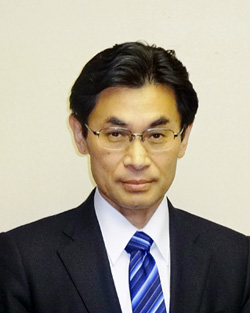
Present position:
Medical Director of Higashi Sapporo Hospital, Sapporo, Japan.
Clinical Professor, Oncology and Hematology Section, Sapporo Medical University School of Medicine, Sapporo, Japan.
Bio-sketch
Born the 18th of January 1960, Takeshi Terui l graduated from medical school of Sapporo Medical University in 1984. He worked as a resident and fellow in, Internal Medicine, Clinical Oncology and Hematology in Sapporo Medical University. He also spend two research programs, one in the Internal Medicine(Ph. D. course of Clinical Oncology and Hematology) in Sapporo Medical University (1985-1989), and one in National Cancer Institute in NIH USA(1992-1994).
He was an assistant professor in Clinical Oncology and Hematology Section in Sapporo Medical University (1995-2003). He joined the Oncology, Supportive and Palliative Medicine team in Higashi Sapporo Hospital in 2003.He has been Medical Director of Higashi Sapporo Hospital since 2008. He has also been a Clinical Professor, Oncology and Hematology Section, Sapporo Medical University School of Medicine since 2012.
He is a Board Certified Gastroenterologist of The Japanese Society of Gastroenterology, a Board Certified Gastroenterological Endoscopist of The Japan Society of Gastroenterological Endoscopy Society, a Board Certified Hematologist of The Japanese Society of Hematology, and a Board Certified Cancer Therapist of Japanese Board of Cancer Therapy.
Recent Publications (Peer-Reviewed Original Research Articles)
- 1. Terui T, Koike K, Hirayama Y, Kusakabe T, Ono K, Mihara H, Kobayashi K, Takahashi Y, Nakajima N, Kato J, Ishitani K: Recent Advances in Palliative Cancer Care at a Regional Hospital in Japan. Am J Hosp Palliat Care 2013 Sep 10. [Epub ahead of print]
- 2. Koike K, Terui T, Takahashi Y, Hirayama Y, Mizukami N, Yamakage M, Kato J, Ishitani K: Effectiveness of multidisciplinary team conference on decision-making surrounding the application of continuous deep sedation for terminally ill cancer patients. Palliat Support Care. 2013 Nov 4: 1-8. [Epub ahead of print]
- 3. Hirayama Y, Terui T, Kusakabe T, Koike K, Ono K, Kato J, Ishitani K: A Survey of Patients Who Were Referred to Our Palliative Care Division From Other Hospitals and Appeared to Have Obvious Indications for Cancer Chemotherapies. Am J Hosp Palliat Care 2013 Oct. 16. [Epub ahead of print]
[Additional comment]
Role of Higashi Sapporo Hospital in Palliative Care
Abstract
More than 30 years have passed since the introduction of the concept of palliative care in cancer care in Japan. However, the majority of the estimated three million cancer patients in Japan do not receive palliative care.
Higashi Sapporo Hospital was established in 1983 as a hospital specialized in cancer care, in particular, palliative cancer care. The palliative care unit (PCU) of our hospital currently consists of 58 beds, and our hospital is one of the largest hospitals in Japan in terms of the number of palliative care beds. Our hospital was certified as a “malignant tumor hospital” in October 2009. On admission to our hospital, all patients are evaluated for palliative care by a multi-disciplinary team and some patients who undergo anticancer therapy receive palliative care when necessary. There are about 65 patients on average (28.3%) who are receiving only palliative care. In 2011, 793 patients died of cancer while admitted at our hospital. This number of cancer deaths accounted for 15% of the 5,324 cancer deaths in Sapporo City in the same year. (Ref 1. Terui T, Koike K, Hirayama Y, Kusakabe T, Ono K, Mihara H, Kobayashi K, Takahashi Y, Nakajima N, Kato J, Ishitani K: Recent Advances in Palliative Cancer Care at a Regional Hospital in Japan. Am J Hosp Palliat Care 2013 Sep 10. [Epub ahead of print]) Our hospital has played an active role according to the philosophy that “palliative cancer care is part of cancer medical care”. I would like to report the current tatus of the contribution of our hospital to overcoming problems in palliative care and cancer care in Japan.
In conclusion, our hospital, focusing on palliative cancer care, plays a different role from large national cancer centers, and can be regarded as a model for local cancer hospitals in Japan.
